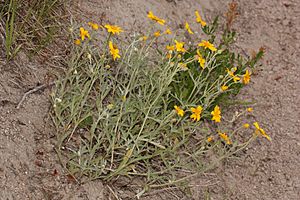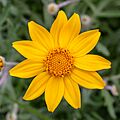Eriophyllum lanatum facts for kids
Quick facts for kids Common woolly sunflower |
|
|---|---|
 |
|
| Dark Divide in Washington | |
| Scientific classification | |
| Kingdom: | |
| (unranked): | |
| (unranked): | |
| (unranked): | |
| Order: | |
| Family: | |
| Genus: |
Eriophyllum
|
| Species: |
E. lanatum
|
| Binomial name | |
| Eriophyllum lanatum (Pursh) Forbes
|
|
| Synonyms | |
|
Synonymy
Actinella lanata Pursh 1813
Actinea lanata (Pursh) Steud. Bahia lanata (Pursh) DC. Helenium lanatum (Pursh) Spreng. Trichophyllum lanatum (Pursh) Nutt. Eriophyllum caespitosum Douglas ex Lindl. Eriophyllum harfordii Rydb. Eriophyllum pedunculatum A.Heller Eriophyllum superbum Rydb. Bahia achillioides DC., syn of var. achillioides Eriophyllum achilleoides (DC.) Greene, syn of var. achillioides Eriophyllum greenei Elmer, syn of var. achillioides Eriophyllum idoneum Jeps., syn of var. achillioides Eriophyllum ternatum Greene, syn of var. achillioides Bahia arachnoidea Fisch. & Avé-Lall., syn of var. arachnoideum Bahia latifolia Lindl. 1853 not Benth. 1844, syn of var. arachnoideum Bahia trolliifolia (Lag.) DC., syn of var. arachnoideum Eriophyllum arachnoideum (Fisch. & Avé-Lall.) Greene, syn of var. arachnoideum Eriophyllum trolliifolium Lag., syn of var. arachnoideum Eriophyllum croceum Greene, syn of var. croceum Egletes californica Kellogg, syn of var. grandiflorum Eriophyllum grandiflorum (A.Gray) Greene, syn of var. grandiflorum Eriophyllum speciosum Greene, syn of var. grandiflorum Bahia cuneata Kellogg, syn of var. integrifolium Bahia gracilis Hook. & Arn., syn of var. integrifolium Bahia integrifolia (Hook.) DC., syn of var. integrifolium Bahia leucophylla D.C.Eaton 1871 not DC. 1836, syn of var. integrifolium Bahia multiflora (Nutt.) Nutt., syn of var. integrifolium Eriophyllum bolanderi Rydb., syn of var. integrifolium Eriophyllum chrysanthum Rydb., syn of var. integrifolium Eriophyllum cineraria Rydb., syn of var. integrifolium Eriophyllum cuneatum Rydb., syn of var. integrifolium Eriophyllum gracile (Hook. & Arn.) A.Gray, syn of var. integrifolium Eriophyllum integrifolium (Hook.) Greene, syn of var. integrifolium Eriophyllum lutescens Rydb., syn of var. integrifolium Eriophyllum monoense Rydb., syn of var. integrifolium Eriophyllum multiflorum (Nutt.) Rydb., syn of var. integrifolium Eriophyllum nevadense Gand., syn of var. integrifolium Eriophyllum trichocarpum Rydb., syn of var. integrifolium Eriophyllum watsonii A.Gray, syn of var. integrifolium Trichophyllum integrifolium Hook., syn of var. integrifolium Trichophyllum multiflorum Nutt., syn of var. integrifolium Eriophyllum lanceolatum Howell, syn of var. lanceolatum Eriophyllum rixfordii Eastw., syn of var. lanceolatum Eriophyllum leucophyllum (DC.) Howell, syn of var. leucophyllum Eriophyllum brachylepis Rydb., syn of var. obovatum Eriophyllum obovatum Greene, syn of var. obovatum |
|
The Eriophyllum lanatum, also known as the common woolly sunflower or Oregon sunshine, is a bright yellow plant. It is a common flower found across North America and belongs to the sunflower family.
Contents
Discovering the Woolly Sunflower
This plant was first seen by the famous Lewis and Clark Expedition. They spotted it growing near their camp on the Clearwater River in what is now Kamiah, Idaho. On June 6, 1806, they collected two samples of this plant.
Later, a botanist named Frederick Traugott Pursh studied the plants from the expedition. He gave the woolly sunflower its first scientific name, Actinella lanata, in his 1813 book. The name "woolly sunflower" is often used for any plant in the Eriophyllum group.
Where Does the Woolly Sunflower Grow?
The Eriophyllum lanatum is native to western North America. It loves sunny, dry places that are less than 10,000 feet (3,000 meters) high. This plant grows best in full sun and well-drained soil. You can also find it on rocky hillsides.
It is very common in California. There, it grows in chaparral areas, oak forests, and pine forests. It also thrives in grassland and sagebrush scrub habitats.
You can find it north through Oregon into British Columbia. It also grows east through Idaho into Wyoming, and through Nevada into Utah. Its range even reaches south into Baja California in Mexico.
What Does the Woolly Sunflower Look Like?
The woolly sunflower is a perennial herb. This means it lives for more than two years. It usually grows to be about 1 to 2 feet (30 to 60 centimeters) tall. The plant often grows in bushy clumps with many branches.
Both the stems and leaves can be covered in soft, gray, woolly hairs. These hairs help the plant save water by reflecting heat. They also slow down air movement around the leaves. This gives the plant a dusty gray color.
The leaves on the upper stems are long and thin. The leaves lower down on the plant have deep cuts, making them look like feathers.
Its Bright Yellow Flowers
The flowers are bright yellow and look a lot like true sunflowers. They can grow up to 2 inches (5 cm) wide. Both the outer ray flowers and the inner disk flowers are yellow. Each flowering stem usually has one flower head.
These cheerful flowers bloom from May to August.
Different Types of Woolly Sunflowers
There are several different types, or varieties, of Eriophyllum lanatum:
- Eriophyllum lanatum var. achillioides — Found in California, Nevada, and Oregon.
- Eriophyllum lanatum var. arachnoideum — Also called the Spiderweb sunflower. It grows only in the California Coast Ranges.
- Eriophyllum lanatum var. croceum — Known as the Sierra woolly sunflower. It grows only in the Sierra Nevada mountains in California.
- Eriophyllum lanatum var. grandiflorum — This is the Large flowered woolly sunflower. It is found in northern California and Oregon.
- Eriophyllum lanatum var. hallii — Also called Fort Tejon woolly sunflower. It grows only in the Tehachapi Mountains and Sierra Madre Mountains in southern California.
- Eriophyllum lanatum var. integrifolium — Known as Oregon sunshine. It grows in many states like California, Idaho, Montana, Nevada, Oregon, Utah, Washington, and Wyoming.
- Eriophyllum lanatum var. lanatum — Found in Idaho, Montana, Oregon, and Washington.
- Eriophyllum lanatum var. lanceolatum — Grows only in the Klamath Mountains in California and Oregon.
- Eriophyllum lanatum var. leucophyllum — Found in British Columbia, Oregon, and Washington.
- Eriophyllum lanatum var. obovatum — Called the Southern Sierra woolly sunflower. It grows only in the western Sierra Nevada and San Bernardino Mountains in California.
Images for kids






